

The event:
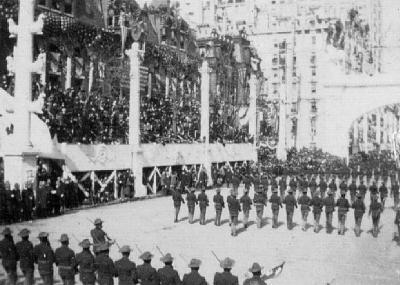
As the Spanish American War ground to a halt, and all that was left
was the final peace treaty, cities across the United States felt the
need to celebrate. The celebrations not only were in honor of the great
victories, but also to celebrate the return of the troops to their
families. Typical of these celebrations was that held in Philadelphia on
October 25, 26, 27 and 28, 1898, known as the Peace Jubilee. The
photographs of this event on this page were taken by Philadelphia
Architect Joseph Wilson (see below for a brief biography of Wilson).
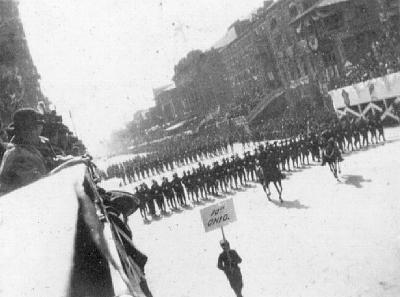
The Jubilee began with a naval parade. Citizens of the city, which was draped in patriotic colors for the occasion, found their way to the waterfront to see the gathering of warships, the ultimate weapons of the day. Secretary of the Navy, John Long, was on hand for the event. As he began his review, a salute was fired, while a Marine band on the Cruiser USS NEW ORLEANS poured out a rousing rendition of Sousa’s “Stars and Stripes Forever" (Click here for a 45 Kb recording of "Stars and Stripes Forever"). The naval parade, led by the USS COLUMBIA, passed in review, coming upriver, pivoting and returning back down river. The pivot point was the Japanese cruiser KASAGI, recently completed by the Cramp Shipyard of Philadelphia.
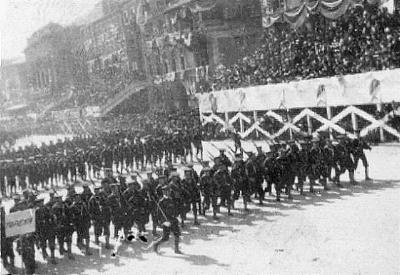
At night, the city was ablaze with light. The “Athenean Arch” and “Court of Honor” had been designed by architect John Huston and constructed for the event. The arch alone, bedecked in nine hundred dollars worth of electric lights, shown brightly…at a cost $450 in electricity. Lamps at the south entrance to the City Hall spelled out “The Star Spangled Banner in Triumph Doth Wave.”
A grand military parade was planned for October 26, but heavy rains forced a postponement . However, the parade stepped off on the 27th at 11:00 A.M. at the corner of Broad and Snyder Streets. The event drew in President and Mrs. McKinley, as well as Vice President and Mrs. Hobart, numerous Cabinet officials and Generals Shafter and Lawton. Over twenty-five thousand troops paraded through the city, including the “Rough Riders” (1st U.S. Volunteer Cavalry), the 9th Ohio Volunteer Infantry, 10th Ohio Volunteer Infantry, as well as the 8th, 13th, 14th, and 15th Pennsylvania Volunteer Infantry, the crew of the USS TOPEKA, and many, many more.
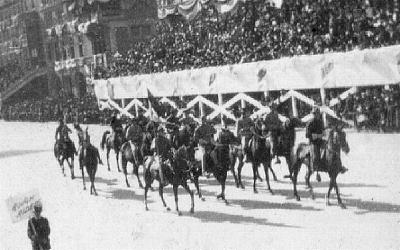
Many of the troops were brought into the city strictly for the parade,
including many encamped at Camp Meade, in Middletown, Pennsylvania. For
many of these men, it was not a pleasant experience. They were brought
by train to the city, through the heavy rains, quartered in some old
factory buildings, and given very little to eat. They marched in the
parade, along a seven mile route, and passed under the Athenean Arch,
and past the Court of Honor. Here the President and others, including Shafter and Lawton,
watched in review. Following the parade, the troops were quickly taken
back out of town. One member of the 8th Pennsylvania
composed a song (sung to the tune of “When Johnny Comes Marching Home”)
which read in part:
“We went to the Philadelphia Peace Jubilee,
Hurrah, Hurrah!
But divil a thing did we get to see,
Hurrah, Hurrah!
We got nothing to eat and marched all day;
When the parade was over they shipped us away;
We’ll be marched to death –
When Company D comes home.”
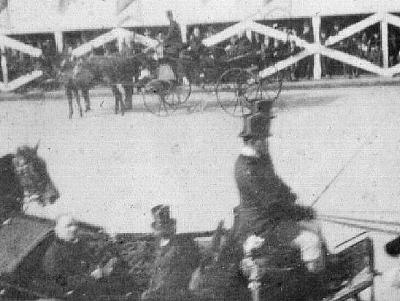
With the parade over, the following day the festivities continued with the next main event of the Jubilee. This was the rededication of Independence Hall, and a large civic parade.
Biography of Joseph Wilson:
The photos shown here were taken by Joseph Miller Wilson. Wilson was a Philadelphia architect and engineer with Wilson Brothers & Company. Wilson had graduated from Rensselaer Polytechnic Institute. In 1860, he was hired by the Pennsylvania Railroad Company as an assistant engineer, eventually becoming engineer of bridges and buildings on the main line of the Pennsylvania Railroad and branches, in special charge of bridge construction. Among the various buildings and bridges he designed and constructed were the Susquehanna and Schuylkill bridges, the original Broad Street Station, the Baltimore and Potomac Station at Washington, and the Main Exhibition Building and Machinery Hall of the 1876 Centennial Exhibition in Philadelphia.
Later, he designed the Drexel Institute, the Drexel Building, Reading Terminal and water filtration system for the City of Philadelphia. Eventually he became engineer of the Reading Railway where he was involved in the design of the Terminal Building and the Pennsylvania Avenue Subway as well the approaches of the Brooklyn Bridge.
Wilson served as president of the Franklin Institute, was a manager of the Drexel Institute and a member of the Photographical Society, among many other affiliations. Wilson passed away November 24, 1902.
"Ohio Troops to Take Part," The Sandusky Star. (Sandusky, Ohio), October 15, 1898, p 3.
Sauers, Richard A., Pennsylvania in the Spanish-American War. (Harrisburg: Pennsylvania Capitol Preservation Committee, 1998) 49-50.
Wright, General Marcus J., Wright's Official History of the Spanish American War. (Washington: War Records Office 1900) 569-573.
The photos by and information on Joseph Wilson was provided by his great-grandnephew Bob Wilson.